A Comprehensive Guide to Yellow Gemstones and Their Significance
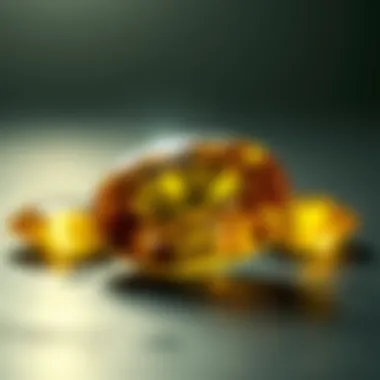
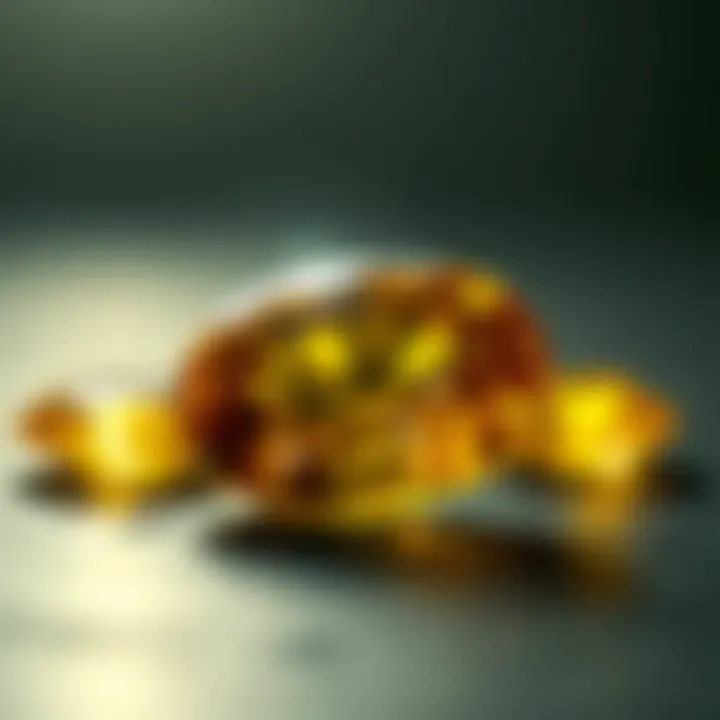
History and Origins
Yellow gemstones have long captivated the human imagination, weaving a rich tapestry of stories that dates back thousands of years. From ancient adornment to contemporary fashion, these stones bear witness to human history, culture, and artistry.
Overview of Collectibles, Rocks, and Fossils
The allure of yellow gemstones often begins with their vivid coloration, a hue synonymous with warmth, optimism, and joy. Varieties such as citrine, yellow sapphire, and topaz each have their unique characteristics that not only enhance their beauty but also appeal to rock and fossil collectors around the globe.
Collectibles in the realm of geology can range from rough uncut stones to intricately polished specimens. The genesis of these gemstones is as varied as the stones themselves. For instance, citrine is a wonderful quartz with a sunny disposition, often formed in volcanic rocks. On the other hand, yellow sapphires belong to the corundum family, demonstrating how minerals transform under extreme conditions, emerging as remarkable treasures deep within the Earth's crust.
Historical Significance and Cultural Impact
Historically, yellow gemstones have held tremendous significance across different cultures. The ancient Egyptians revered yellow jasper, believing it to possess protective powers. Similarly, Hindu culture recognizes yellow sapphire as a symbol of wisdom and prosperity, often adorning the robes of kings and being utilized in rituals. A prime example is the yellow diamond, which has been worn by notable figures such as Kate Middleton and Elizabeth Taylor, adding to its cultural cachet and enhancing its desirability as a gem.
"Gemstones can tell us more about history than history books."
Thus, for collectors, yellow gemstones represent not only an investment but an intersection of culture, story, and mineralogy, underpinning their worth in both aesthetic and historical contexts.
Identification and Classification
Navigating the world of yellow gemstones requires some degree of knowledge about their characteristics. Learning how to identify these gems can help collectors detect authenticity and appreciate their value fully.
Guide to Identifying Rocks and Fossils
When determining the authenticity of a yellow gemstone, seasoned collectors often consider specific traits:
- Color: The hue can vary significantly, even within the same type of gemstone. Citrine can range from pale yellow to deep amber.
- Hardness: The Mohs scale can be a useful guide; thus, yellow sapphire scores a commendable 9, while citrine ranks at 7.
- Clarity: Look for inclusions within the gemstone; natural flaws can often mean authenticity, whereas perfect stones might suggest synthetics.
- Cut: A well-cut stone often enhances brilliance, a factor that may appeal to buyers and collectors alike.
Common Types and Variations
Several yellow gemstones have become staples in jewelry and collections:
- Citrine: Known for its cheerful golden hue, this quartz variant is said to attract wealth and prosperity.
- Yellow Sapphire: A prized jewel in many cultures, it’s renowned for its clarity and brilliance.
- Yellow Diamond: Rarer than its clear counterpart, this gem is marked by its stunning colors and is coveted by collectors.
- Amber: While sometimes classified differently, this fossilized tree resin can contain unique inclusions, making it a fascinating collectible.
For further insights on yellow gemstones and their geological formations, consider visiting resources such as Wikipedia and Britannica. These platforms offer a wealth of information on various minerals and their histories, enriching any collector's knowledge.
Understanding Gemstones
Gemstones have captivated humanity for centuries, serving not just as adornments but also as symbols of power, status, and beauty. A deeper understanding of gemstones can enrich one’s appreciation for their rarity, the stories they embody, and their role in personal and cultural narratives. This segment focuses on crucial components of gemstones, considering factors like their definitions, classifications, and the fundamental influence of color on identification. All these elements come together to make gemstones a subject worthy of exploration.
Definition and Classification
When we talk about gemstones, we aren't just referring to pretty rocks. Gemstones are defined as hard, crystalline materials that are generally prized for their beauty and durability. Most commonly, they are categorized into precious and semi-precious stones. This classification is not merely arbitrary; it reflects historical usage, collection interests, and market values.
Precious gemstones include diamonds, rubies, emeralds, and sapphires—often considered the royalty of the gemstone kingdom. On the other hand, semi-precious stones such as amethyst, garnet, and quartz, while beautiful, may not command the same prices. It is essential to note, however, that the designation of 'precious' or 'semi-precious' doesn't always correlate with the gemstone's inherent qualities but rather with societal values and demand.
The classification can also extend based on the stone's chemical composition, origin, and physical properties. For example, the term beryl encompasses varieties like emerald and aquamarine. Each variety comes with its unique hue, transparency, and overall optical characteristics. This classification method creates a framework for collectors and enthusiasts to understand the diverse world of gemstones.
The Role of Color in Gemstone Identification
Color is a primary identifier in the gemstone world. It is without question one of the most visible traits that affect how a gemstone is perceived. The intensity, saturation, and hue can all heavily influence a gemstone's market value. Take the striking example of topaz—this gem can be found in various shades, including blue, clear, and yellow. Yet, its yellow form, often referred to as imperial topaz, is particularly sought after for its warm glow, reminding one of a summer sun.
Colors can also influence jewelry design. In some cultures, certain colors are believed to bring luck or possess healing properties. Yellow gemstones, for instance, are often associated with warmth, positivity, and energy. This connection to color psychology makes them popular choices, especially in jewelry intended for celebrations or special occasions.
The science behind gemstone color involves the interplay of structure, light, and impurities. For instance, most gemstones display their true color under natural sunlight rather than artificial lights, which might shift their hue. Understanding these nuances helps collectors not only recognize authentic stones but also appreciate their unique beauty more profoundly.
"The shade of a gemstone can influence its perceived value, making color knowledge indispensable for collectors and enthusiasts alike."
Overview of Yellow Gemstones
The allure of yellow gemstones captivates many, not just in the realm of jewelry but also in the vibrant spectrum of nature itself. Known for their sunny hues and associated meanings, these gems symbolize positivity and warmth. Diving into this topic reveals the multifaceted nature of yellow stones, their allure extending beyond mere aesthetics.
Yellow gemstones hold a unique position in the world of gemology. Their color, often reminiscent of sunlight, evokes feelings of joy and brightness, which translates well into various applications. Understanding the essence and classification of these gemstones is crucial for collectors and enthusiasts. This section delves into the significance of yellow gems not only in the context of their physical attributes but also in cultural and emotional realms.
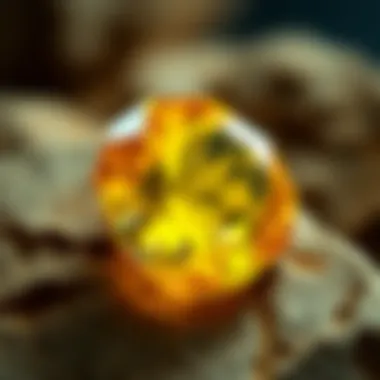
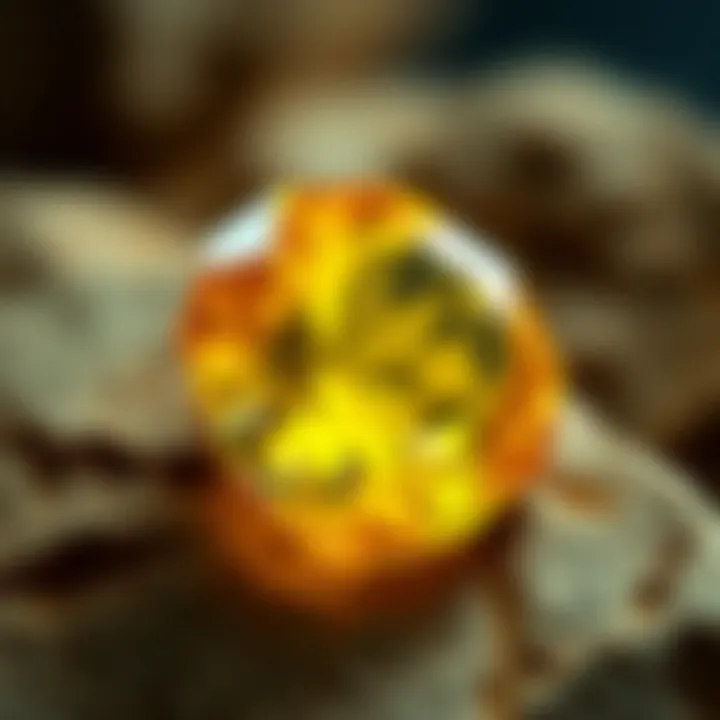
Significance of Yellow in Gemology
In gemology, yellow is not just a color; it’s a signal of vibrancy and life. Within the gemological community, yellow signifies a stone's ability to capture light and energy. Such stones, like citrine or yellow sapphire, often have specific uses attributed to their composition and hue. For instance, many believe yellow gemstones possess healing properties.
In various cultures, yellow is imbued with meanings ranging from enlightenment to abundance. In China, for example, it is historically associated with power and royalty. Knowing this cultural context adds depth to the appreciation of yellow gemstones. All of these factors contribute to their significance in gemology, reflecting both natural beauty and metaphysical connections.
Desirable Qualities of Yellow Gemstones
When evaluating yellow gemstones, several qualities come into play that define their desirability. Below are some essential traits:
- Color Quality: The intensity and depth of the yellow hue are paramount. A vibrant yellow often fetches higher values.
- Clarity: Stones with fewer inclusions are more prized. Clarity influences both the gemstone's beauty and its market value.
- Cut: The craftsmanship of the cut influences how well a stone reflects light. Well-cut stones will showcase their color beautifully and have a higher appeal for collectors.
- Carat Weight: The size of the gemstone can impact its desirability, especially in the case of rare yellow gems.
In essence, when pursuing yellow gemstones, contribute your focus on these criteria. Doing so can enhance your collection and elevate your enjoyment of these radiant treasures.
"Yellow gemstones are not only visually stunning; they often reflect deeper meanings, connecting collectors to both beauty and culture."
Understanding these qualities fosters a deeper appreciation as one navigates the fascinating world of yellow gemstones, ensuring that every piece acquired is not just a gem, but a story waiting to be told.
Popular Yellow Gemstones
The allure of yellow gemstones lies not just in their vibrant color but also in their wide applications and rich histories. Each type of yellow gemstone brings its own unique characteristics, and understanding these can help enthusiasts and collectors make informed decisions. Knowing the benefits of these stones—be it in jewelry, investment, or metaphysical beliefs—can enhance one's appreciation of them. Let's explore some of the most notable examples of these brilliant gems, unearthing the qualities that make them desirable and significant.
Citrine: The Golden Quartz
Citrine is often regarded as the merchant's stone due to its reputed ability to attract wealth and prosperity. What sets it apart is its beautiful, warm yellow hue that can vary from pale to deep amber shades. Mostly found in Brazil, Madagascar, and Spain, this variety of quartz boasts impressive durability, making it a popular choice for everyday wear in jewelry.
Citrine has been utilized in adornments for centuries, believed to carry the sun's energy, instilling joy and positivity in its wearer. It is often seen in rings, necklaces, and earrings, where its natural sparkle enhances artistic designs without overshadowing them. Also, one can easily find citrine at a range of price points, making it an accessible gem for many.
Yellow Sapphire: A Precious Gem
Yellow sapphire is among the big players in the gemstone world due to its rarity and regal qualities. This gemstone exudes a rich shade of yellow that conveys luxury and elegance. Sourced predominantly from locations like Sri Lanka and Thailand, yellow sapphires are not only stunning but also hold significant value on the market.
In various cultures, yellow sapphire is thought to bring clarity of thought, prosperity, and peace to its wearer. This stone's hardness (9 on the Mohs scale) makes it suitable for a range of jewelry designs, from simple solitaires to intricate settings. Moreover, many believe that wearing a yellow sapphire can enhance personal energy and strengthen one's willpower.
Topaz: From Blue to Golden
Topaz is a versatile gemstone known for its wide array of colors, with yellow being one of the most sought after. Originating primarily from Brazil, the United States, and Sri Lanka, yellow topaz can display shades from pale yellow to golden amber. Its clarity and brilliance make it a magnificent addition to any jewelry collection.
This gemstone enjoys a rich history: it has been believed to ward off evil and promote love and friendship. With a hardness of 8 on the Mohs scale, yellow topaz can withstand daily wear well. As such, it is frequently set in various types of jewelry, often paired with complementary stones for enhanced visual appeal.
Beryl: The Versatile Family
Beryl serves as a comprehensive family of gemstones that encapsulates a variety of colors, with yellow beryl, also known as heliodor, being one of its most delightful forms. Found mainly in Brazil and Madagascar, yellow beryl embodies a bright lemon hue and is less common than its green or blue relatives.
Though not as well-known as other yellow gemstones, yellow beryl exhibits impressive durability and a simple beauty that makes it appealing for both casual and formal jewelry pieces. This stone is considered a stone of good fortune, often believed to cultivate harmony in relationships. Wearing it can inspire courage and promote self-assurance, making it a treasured gem for many.
Amber: Natural Beauty Preserved
Amber is not a typical gemstone formed through crystallization; instead, it is fossilized tree resin, giving it a distinct appeal and organic quality. Its warm yellow hues make it a true gem of nature, with colors varying from pale yellow to deep orange.
Unlike most gemstones, amber is lightweight and often includes intriguing inclusions, providing a glimpse into ancient life. This organic origin links amber to various historical and cultural practices; it has been valued for centuries not just for its beauty, but also for its supposed healing properties. Making jewelry from amber often involves carving intricate designs, allowing for personalized pieces that carry a story.
Golden Tourmaline: A Rarity
Golden tourmaline is a lesser-known gem that merits attention for its dazzling appearance. Often exhibiting shades of yellow and golden hues with possible bi-colored variations, this stone originates from regions like Brazil and Afghanistan. Its rarity adds to its charm and appeal in the collector's market.
This gemstone is celebrated not only for its beauty but also for its believed metaphysical properties. It is said to promote optimism and energize the spirit. Jewelry featuring golden tourmaline can often be found in bespoke designs, further enhancing its uniqueness.
"Yellow gemstones often symbolize joy, prosperity, and clarity, making them essential for personal and spiritual growth."
Geological Properties of Yellow Gemstones
Understanding the geological properties of yellow gemstones is central to appreciating their beauty and value. The conditions under which these gemstones form not only influence their appearance but also dictate their rarity and desirability. Intricacies like formation processes, extraction methods, and the stones' physical and chemical attributes shape how collectors and enthusiasts view these natural marvels.
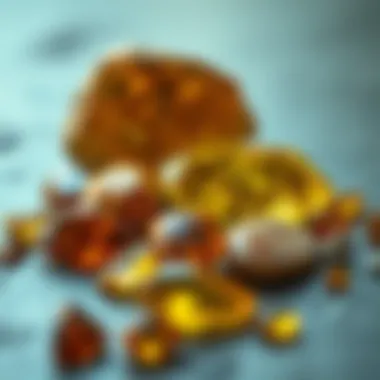
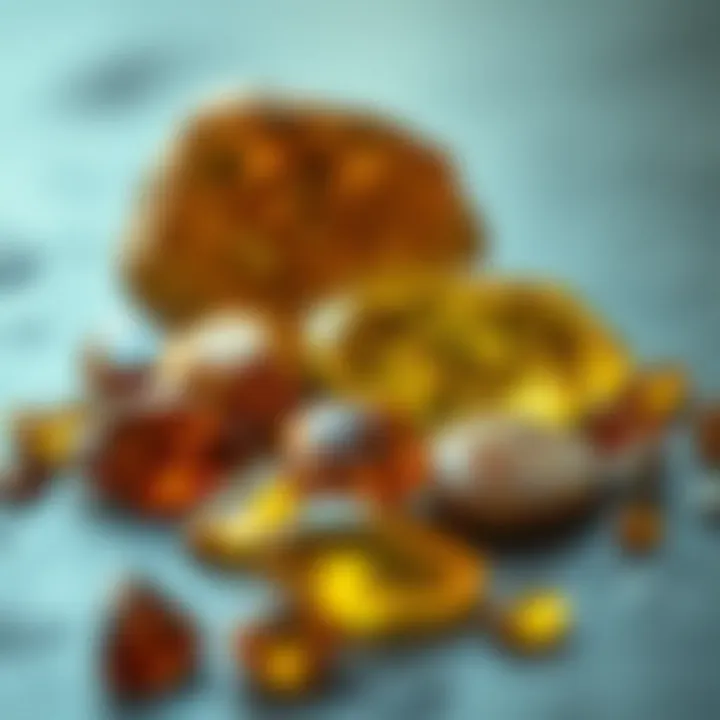
Formation and Extraction
The journey of a yellow gemstone begins deep within the Earth. Most yellow gemstones form under high-pressure and high-temperature conditions, often from mineral-rich magma or hydrothermal solutions. For example, citrine, a popular yellow stone, mainly forms through natural heat processes, sometimes via the amethyst variety when subjected to specific conditions. Another striking example is yellow sapphire, which originates from metamorphic rocks rich in aluminum and oxygen.
Mining techniques vary by gemstone type. For instance, yellow tourmaline is primarily harvested from pegmatites in Brazil, while citrine is often found in Brazil and Uruguay, sometimes extracted from the earth through open pit mining. The extraction not only demands skill but also environmental responsibility, considering the ongoing discussions around sustainable practices in the gemstone industry. Gemstone mining can easily tip into destructive operations if not managed properly.
Physical and Chemical Properties
The allure of yellow gemstones includes a blend of their physical beauty and chemical composition. Each gemstone boasts unique characteristics that make it fascinating. To illustrate:
- Citrine and Amethyst are both quartz variants, with citrine being the yellow form of quartz. Typically, this stone is rated 7 on the Mohs hardness scale, rendering it reasonably durable for everyday wear.
- Yellow Sapphire, rich in aluminum oxide, has a significantly higher hardness rating of 9, showcasing exceptional durability. This makes it a prime candidate for engagement rings and various types of jewelry designed for daily use.
- Topaz, another prominent yellow gemstone, features its own distinct traits including its pleochroism, which allows it to showcase different hues when viewed from different angles.
"Yellow gemstones symbolize joy, energy, and optimism, often associated with sunlight and warmth."
Collectors should also note the crystal structures of these stones, which vary prominently across different yellow gemstones. While citrine displays a hexagonal crystal system, yellow beryl has a distinctly different arrangement. This diversity not only enriches their aesthetic appeal but also impacts how light interacts with the gemstones, creating various optical phenomena like brilliance and fire.
Cultural Significance of Yellow Gemstones
The cultural significance of yellow gemstones extends far beyond their dazzling visual appeal; these stones carry rich histories, multifaceted meanings, and associations deeply rooted in various traditions. Their vibrant hues have captivated people across cultures and epochs, making them symbols of prosperity, courage, and vitality. Understanding these meanings not only enriches our appreciation for these gems but also highlights their relevance in both personal and communal narratives.
Historical Uses and Beliefs
Historically, yellow gemstones have been utilized in myriad ways, cherished not only as adornments but also as talismans. For instance, during ancient times, the Egyptians revered yellow stones, particularly amber, regarding them as symbols of the sun. They believed that these gems held protective qualities, warding off negative energies and bringing luck. The Greeks, too, valued yellow gemstones, associating citrine with the goddess of wealth, Plutus, and using it to attract abundance.
In various cultures, yellow stones like the yellow sapphire were thought to promote mental clarity and enhance creativity. Many scholars in the East believed that wearing these stones could imbue the wearer with wisdom and encourage successful endeavors. Meanwhile, Native American tribes often incorporated yellow gemstones in their rituals, utilizing them to signify life and vitality, making them essential elements in spiritual ceremonies.
This rich tapestry of historical beliefs has helped yellow gemstones maintain their allure throughout the ages, constantly weaving their significance into the fabric of cultural identity.
Contemporary Symbolism and Associations
In modern society, yellow gemstones continue to hold symbolic weight. They are seen as embodiments of optimism and rejuvenation. For many, the brightness of these stones represents hope and a fresh start. Yellow has a psychological impact, often associated with joy and energy, making gemstones like citrine popular choices for those seeking to uplift their spirits.
When it comes to jewelry, yellow gemstones are frequently chosen for wedding bands and anniversary gifts due to their connotations of warmth and friendship. They are believed to foster positive relationships, encouraging open communication and understanding among partners. In the realm of mindfulness and personal development, these stones are regarded as catalysts for self-expression and confidence, empowering individuals to embrace their true selves.
"Yellow gemstones serve as a constant reminder of the light, happiness, and warmth we can aspire to cultivate in our lives."
With the rise in awareness about ethical sourcing and sustainability, modern consumers are also more inclined to choose gemstones that align with their values. This awareness magnifies the cultural significance of yellow gemstones, transforming them into powerful symbols of conscious living, reflecting both the beauty of nature and the importance of responsible practices.
The enduring legacy of yellow gemstones is now more relevant than ever, as they continue to bridge the past with contemporary interpretations, enriching both personal connections and broader cultural narratives.
For further reading on gemstones and their cultural implications, you may explore resources such as Britannica and Wikipedia.
Care and Maintenance of Yellow Gemstones
When it comes to yellow gemstones, keeping them in tip-top shape is essential for maintaining their beauty and value. Just like any precious item, these gems need a bit of extra attention to truly shine. Proper care and maintenance not only prolongs their vibrancy but also preserves their intrinsic worth as investment pieces in your collection. The age-old saying goes, "an ounce of prevention is worth a pound of cure," and that's certainly true when dealing with these radiant stones.
Cleaning and Storage Tips
Yellow gemstones, each with unique compositions and durability, require specific cleaning methods to maintain their luster without causing damage. Here are some straightforward tips to remember while tending to these glittering treasures:
- Gentle Cleaning: Use warm, soapy water and a soft cloth to gently clean your yellow gemstones. Avoid harsh chemicals which can cause discoloration or degradation. Specifically, using mild dish soap can work wonders.
- Avoid Ultrasonic Cleaners: While they might sound appealing, ultrasonic cleaners can cause fractures in more sensitive stones like yellow sapphire or light beryl, leading to catastrophic damage. Stick to simple methods.
- Proper Storage: Keep your yellow gemstones away from direct sunlight when not in use. Prolonged exposure can lead to fading. Storing them in a cushioned box, or in compartments that prevent them from scratching each other, is advisable. Small pouches or wrapped in soft cloth can also do the trick for more delicate pieces.
- Regular Check-ups: Every so often, inspect your gemstones for any accumulation of dust or dirt. A quick clean can often prevent gunk from hardening, making your routine simpler in the long run.
Identifying and Reporting Damage
Even with the best care, sometimes mishaps can happen. It's crucial to be vigilant about any damage to your yellow gemstones. Here are some pointers to help identify issues and take appropriate steps if needed:
- Visual Inspection: Regularly check for scratches, abrasions, or chips. A simple look under a magnifying glass can help you spot issues that might not be visible to the naked eye.
- Feeling for Roughness: Run your finger gently over the surface of the stone. If it feels rough or uneven, that's a red flag. A damaged gemstone can lose its appeal and value over time.
"One man's trash is another man's treasure." You might find it beneficial to report damage immediately to your jeweler, especially if it's a more valuable piece. They can often provide repair services or advice on whether a more extensive restoration is needed.
- Documentation: If you note any damage, document it. Photographs with close-ups can help both in assessing the issue later and when discussing repairs with professionals. Having a detailed record can also assist in any claims if your stone is insured.
Market Trends for Yellow Gemstones
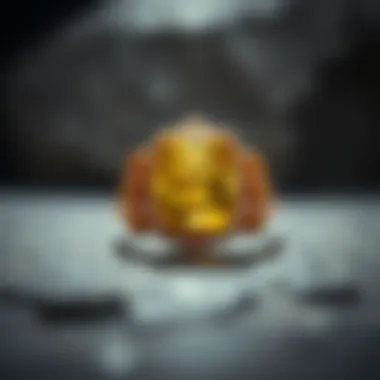
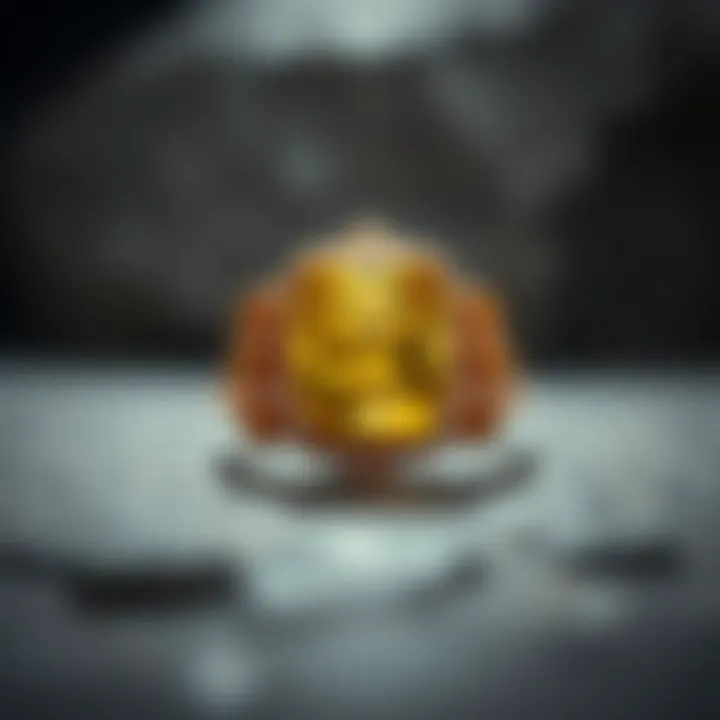
The market dynamics surrounding yellow gemstones reveal intriguing patterns, influenced by consumer preferences, cultural significances, and technological advancements. Understanding these trends is essential for collectors and enthusiasts alike, providing insight into not just the aesthetic qualities of these gems, but also their market viability. Given the increasing interest in ethical sourcing and sustainable practices, the demand for yellow gemstones is expected to evolve, highlighting their value beyond mere adornment.
Valuation Factors
When it comes to assessing the worth of yellow gemstones, several key factors come into play. Collectors and jewelers alike consider:
- Color Quality: The vibrancy and hue of yellow gemstones can significantly affect their value. A rich, golden hue often commands higher prices than pale or overly saturated shades.
- Clarity and Cut: The absence of inclusions and the skill of the cut not only enhance the stone's beauty but its market value too. A well-cut gem that sparkles with clarity can fetch a premium.
- Rarity: Scarcity elevates a stone's desirability. Unique varieties, or those sourced from specific locations known for quality, often see increased market interest.
- Certification: Authenticity and grading certificates from renowned gemological institutes add credibility, impacting resale value. Buyers tend to pay more for certified gemstones, assuring quality and legitimacy.
Knowledge of these factors helps collectors make informed decisions when navigating the yellow gemstone market.
Investment Potential
Investing in yellow gemstones can be as rewarding as it is fascinating. The appeal to collectors is growing, prompting many to view them not just as jewelry, but as valuable assets. Key considerations include:
- Market Demand: An uptick in interest for alternative investments has led many to gemstones, including yellow varieties. As consumer awareness rises about the unique characteristics of these gems, we can expect increased demand.
- Long-Term Value: While purchasing gems isn't without risk, historical data shows that certain stones hold or even appreciate in value over time. Yellow sapphires and certain types of topaz have proven to be sound investments in the past.
- Diversity of Use: Yellow gemstones are versatile in the jewelry market, often featured in various styles. This adaptability can enhance their marketability and long-term desirability.
Keeping an eye on market trends and potential for growth is prudent for anyone considering investing in yellow gemstones. The synthesis of aesthetic appreciation and informed investment can yield gratifying outcomes in an ever-evolving market.
Crafting Jewelry with Yellow Gemstones
Yellow gemstones aren't just pretty to look at; they have a rich history and a vibrant energy that makes them particularly desirable in jewelry making. Incorporating these gems into jewelry has become a popular choice not only because of their stunning aesthetics but also due to their metaphysical properties and cultural significance. As more collectors and enthusiasts recognize the value of these stones, understanding the art and science behind crafting jewelry becomes crucial.
When it comes to crafting jewelry with yellow gemstones, several elements come into play. The specific quality and unique characteristics of each gemstone can vastly influence design choices. For instance, a bright citrine may lend itself to a more playful design, while a regal yellow sapphire might demand a more elegant approach. Here are a few aspects to consider:
- Gemstone Quality: Clarity, cut, color, and carat weight can significantly affect how the final piece will look. High-quality stones tend to catch more light, enhancing their brilliance.
- Metal Selection: The choice of metal can either complement or clash with the gemstone. For instance, yellow gold often enhances the warmth of yellow stones, while platinum or sterling silver provides a modern, sleek contrast.
- Intended Use: Understanding where and how the jewelry will be worn is vital. Everyday items might require more durable settings, while pieces intended for special occasions can afford to be more delicate.
These considerations not only showcase the versatility of yellow gemstones but also ensure that the finished piece is both beautiful and functional.
Design Considerations
Effective design lies at the heart of crafting jewelry with yellow gemstones. Each stone tells its own story; hence, how they're set and styled can change their impact tremendously. Here are some key design considerations:
- Shape and Cut: The shape of a gemstone, such as cushion, oval, or round, can dictate the overall style of the jewelry. A brilliantly cut stone will catch the eye far more than a poorly cut one.
- Setting Style: Whether you opt for a prong, bezel, or pave setting, each choice affects how light interacts with the gemstone. A prong setting allows more light to enter the stone, enhancing its sparkle, whereas bezel settings can emphasize a stone's shape and color.
- Color Combinations: Integrating complementary colors can elevate a piece to new heights. For instance, pairing yellow gemstones with deep blues or rich greens can create a striking contrast, while softer tones may create a more subtle harmony.
Designers must also keep practicalities in mind, ensuring pieces are not just visually appealing but also wearable and durable.
Popular Jewelry Styles Featuring Yellow Gemstones
Yellow gemstones lend themselves beautifully to various types of jewelry designs. Some popular styles that showcase these vibrant gems include:
- Statement Rings: A large yellow sapphire or citrine set in an intricate band can serve as a stunning focal point on any hand.
- Earrings: Drop earrings featuring amber or golden tourmaline can add a sophisticated touch, perfect for both casual and formal occasions.
- Necklaces: A simple pendant with a striking yellow gemstone can convey elegance without being overly flashy, while more complex designs may incorporate multiple stones for added drama.
- Bracelets: Utilizing yellow gems in tennis or charm bracelets can create a stunning accessory that sparkles in any light.
"Jewelry is a very personal thing. It should tell a story about the person who’s wearing it."
By focusing on the significance of yellow gemstones in jewelry making, enthusiasts can appreciate the multi-faceted nature of these stones, not just as decorative items but as vibrant pieces of art that resonate with their wearer.
The Future of Yellow Gemstones
The world of yellow gemstones is at a fascinating crossroad, where tradition meets modernity. As we peer into the future of these radiant stones, it’s clear that sustainability and ethical sourcing are becoming non-negotiable in the gemstone market. This growing awareness is not just a passing trend; it stems from an increasing desire to ensure that the beauty of yellow gemstones comes with a clear conscience. Therefore, it’s imperative to examine what sustainability and innovation will mean for the future of these beloved gems.
Sustainability and Ethical Sourcing
Many gemstone enthusiasts today prioritize knowing where and how gemstones were sourced.
Sustainability in the gemstone industry relates to practices that help protect the planet while ensuring that mining is as environmentally friendly as possible. This includes reducing water usage, minimizing soil erosion, and preventing pollution. The driving force behind this demand for ethical sourcing is the shift in consumer behavior, as more buyers want to ensure their purchases align with their values. Transparency becomes crucial in transforming the industry.
A few notable concepts in sustainable practices include:
- Traceability: Customers can trace the origin of the stones they purchase, providing assurance they are not contributing to unethical practices.
- Small-Scale Mining: Supporting independent miners who use eco-friendly techniques to extract gemstones can foster local economies while protecting the environment.
- Recycled Gemstones: Embracing the recycling of existing gemstones has gained traction. It offers a fantastic alternative that reduces demand for new mining activities.
"The future belongs to those who believe in the beauty of their dreams – and who act responsibly to realize them."
Emerging Trends and Innovations
In tandem with sustainability, emerging trends in the gemstone market signal exciting developments. Advances in technology and changing design preferences are vital players in shaping the future of yellow gemstones. Here are a few key trends:
- Synthetic Gemstones: The production of lab-created yellow stones like synthetic yellow sapphires and citrines offers a conflict-free alternative. While some purists prefer natural stones, synthetic options have gained popularity due to their affordability and sustainability.
- Blockchain Technology: This innovation helps in tracing the history of gemstones throughout the supply chain. By adopting such technologies, buyers can feel more secure knowing that what they purchase is ethically sourced.
- Unique Cuts and Designs: Jewelry designers are embracing new cutting techniques, making yellow gemstones shine like never before. From intricate faceting to unconventional shapes, new styles are appealing to diverse consumer tastes and making yellow stones more desirable.
For further knowledge and resources, you can visit:



